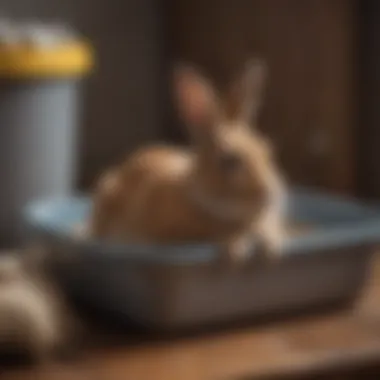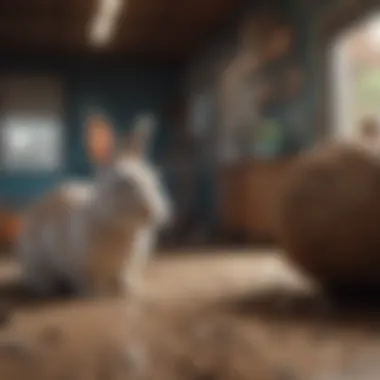Litter Training Your Rabbit: A Comprehensive Guide


Intro
Litter training a rabbit is a significant aspect of responsible pet ownership. Understanding the challenges and behavioral traits involved can greatly aid in this process. It is essential to know that rabbits can be trained to use a litter box, similar to cats, provided the owner is patient and knowledgeable about the proper techniques.
Understanding Your Pet
Pet Behavior Basics
Rabbits are social animals with unique behavioral traits. They can be skittish and may have a strong instinct to hide from perceived threats. However, they also create strong bonds with their owners and can become accustomed to certain routines and signals. Identifying your rabbit’s habits is critical when initiating litter training.
Common Breed Characteristics
Different breeds of rabbits may exhibit varying personalities. For instance, Holland Lops are often friendly and easy to train, while Lionheads are curious but may require more patience. Understanding the breed-specific characteristics can help set realistic expectations for training.
Species-Specific Needs
Rabbits need a safe environment, a balanced diet, and appropriate mental stimulation. They are also territorial, which often means they will prefer to eliminate in specific areas. This territorial instinct can be leveraged in litter training.
Training and Development
Behavioral Training Techniques
Training rabbits requires understanding their natural instincts. Positive reinforcement works best. Rewarding them with treats when they use the litter box can encourage this behavior. It is crucial to be consistent in rewarding good behavior and to avoid any negative reinforcement.
Addressing Common Behavior Issues
If a rabbit refuses to use a litter box, it may be due to stress or discomfort. Stress can arise from environmental changes, lack of space, or even the presence of other pets. If issues persist, a veterinarian visit can rule out medical problems.
Consistency, patience, and love are keys to success in litter training your rabbit.
Pet Care and Maintenance
Hygiene Practices
Maintaining cleanliness is vital for the health of your rabbit. Regularly clean the litter box, removing waste and providing fresh litter material. This habit not only contributes to a healthy environment but also reinforces litter training.
Health and Wellness
Routine Vet Check-ups
Regular veterinary checks ensure that your rabbit remains healthy. Some health issues can directly affect behavior and, consequently, litter habits. Familiarity with your veterinarian helps create a reliable health plan for your pet.
Enrichment and Activities
Indoor vs.
Outdoor Activities Providing a stimulating environment is essential. Indoor rabbits can enjoy toys, tunnels, and exercise pens, while outdoor rabbits benefit from safe enclosures. Each environment presents unique opportunities for play and exploration, which can help solidify the litter training process by keeping the rabbit engaged.
Interactive Toys and Games
Interactive toys can prevent boredom and reduce stress. Activities that encourage digging or foraging can also help mimic natural behaviors, allowing your rabbit to feel more comfortable in their space.
Culmination
Litter training is not just about having a clean home. It contributes to the overall well-being of your rabbit by fostering trust between the pet and owner. By understanding your rabbit’s behavior and needs, you can create a safe, enjoyable environment that encourages good habits. With patience and consistent effort, you can enjoy a harmonious relationship with your pet.


Understanding Rabbit Behavior
Understanding rabbit behavior is critical when considering litter training. Rabbits are creatures of habit, and their natural instincts can significantly influence their ability to learn new behaviors. Appreciating how rabbits behave in their environment helps owners create conditions that favor successful litter training.
Natural Instincts and Habits
Rabbits are prey animals, and as such, their instincts guide much of their behavior. In the wild, they choose specific spots to urinate and defecate. These areas are often far from their living and feeding spaces. This instinct makes rabbits conducive to litter training, as they naturally seek to maintain a clean living space.
Furthermore, it is worth noting that most rabbits will develop a routine regarding bathroom habits. By observing when your rabbit tends to use the restroom, you can align the training process with their natural habits. Initially, you may notice that your rabbit prefers certain locations in its enclosure for this purpose. This behavior can inform you as you decide where to place the litter box.
Socialization and Space Needs
Rabbits are social creatures who are most comfortable in environments that provide ample space to roam. They thrive when they have space to explore and interact, which includes areas for playing and resting. When considering litter training, you must create an environment that caters to their social nature.
An adequate living space facilitates bonding between the rabbit and its owner. Rabbits that feel secure are more likely to adapt to litter training. An enclosed area with a correct balance of secure hiding spots and open play areas allows the rabbit to feel at ease, thus making it more amenable to learn.
Creating an environment that respects your rabbit's instincts and social needs helps forge a strong connection. This bond is essential for a successful training journey.
Understanding your rabbit's natural instincts and social needs plays a pivotal role in the success of litter training.
The Basics of Litter Training
Defining Litter Training
Litter training for rabbits involves teaching your pet to use a designated area for urination and defecation. This is similar to how some other pets like cats are trained. The process redirects their natural instinct to claim territory by marking it with waste. Rabbits tend to seek out specific spots for their business, making them capable candidates for litter training. This potential eases the process significantly. The litter box becomes a place associated with comfort and safety, which aligns with a rabbit’s instinctual behaviors. Thus, defining litter training not only highlights the feasibility but also indicates the importance of understanding your rabbit's behavior.
Why Consider Litter Training?
Litter training your rabbit can bring various advantages that improve both the pet's and the owner’s experience. Some key benefits include:
- Hygiene: Rabbits can be neat creatures. By using a litter box, they minimize the mess, making it easier for you to maintain a clean living environment.
- Behavioral Encouragement: Successful litter training reinforces positive habits. It helps rabbits learn more about their space, contributing to a calmer demeanor.
- Bonding Opportunities: The training process can deepen the bond between you and your rabbit. It involves interaction and rewards, enhancing mutual understanding and trust.
- Freedom of Movement: Once litter trained, you can give your rabbit more space to roam freely in the house without constant worry about accidents.
According to experienced rabbit owners, litter training not only benefits cleanliness but also enriches the bond between pet and owner.
In summary, considering litter training is a practical step toward a more organized, pleasant living environment for both you and your rabbit. By defining the training process clearly and understanding its benefits, you pave the way for a successful pet-owner relationship.
Choosing the Right Materials
Choosing appropriate materials for litter training your rabbit is crucial. The right materials not only enhance the efficiency of the training process but also ensure your rabbit's comfort and health in their new environment. Understanding which types of litter to use, as well as selecting the right size of litter box, plays a significant role in pleasing both you and your rabbit.
Litter Types: What Works Best?
Different types of litter vary in their suitability for rabbits. A few notable options are:
- Paper-based litters: Made from recycled paper, these litters are highly absorbent. They are also safe if ingested, making them a wise choice for rabbits.
- Wood pellets: These are durable and control odors well. However, ensure they are untreated and free from harmful chemicals.
- Aspen shavings: Unlike cedar or pine, aspen is safe for rabbits. It offers good absorption and can help in managing smells.
- Fleece liners: Though not traditional litter, fleece can be used as bedding. It needs regular washing but can create a cozy space for your rabbit.
Consider avoiding litters that contain clumping agents or fragrances. These can be harmful when ingested and may deter rabbits from using their litter box.
Selecting the Litter Box Size
The size of the litter box is another important consideration. A properly sized litter box allows your rabbit to easily enter and exit, offering enough space to move around inside. Generally, the litter box should be at least as wide as your rabbit, with some extra room for comfort.
For medium to large rabbits, a litter box that measures at least 24 x 24 inches will suffice. Smaller breeds may require less space, but it is still vital to allow for movement. Here are a few tips for selecting the right size:
- Height of the sides: Ensure low enough sides for easy access, particularly for older rabbits.
- Entrances: Some litter boxes come with a lid or cover. Make sure the entrance is large enough for your rabbit to hop in comfortably.
- Ease of cleaning: A larger box might require more maintenance, but ensure it is manageable for you to clean regularly.


By taking the time to choose the right litter type and litter box size, a harmonious litter training experience can vastly improve life with your rabbit.
Remember, comfort encourages consistency in using the litter box. Prioritize your rabbit's preferences to enhance the likelihood of successful training.
Establishing a Training Routine
Creating a consistent training routine is critical for litter training a rabbit. This structure not only helps the rabbit understand where to go but also reinforces good habits. A routine fosters security and predictability in the rabbit's environment, essential for effective training.
Rabbits thrive in familiarity. They have a natural inclination to repeat behaviors that yield positive outcomes. When a rabbit recognizes a designated area for elimination, they are more likely to use it consistently. Consistency is crucial, as it allows the rabbit to form associations between the litter box and their bathroom habits.
Setting Up the Training Environment
Your training environment should be conducive to learning. Begin by selecting a quiet, easily accessible location for the litter box. This spot should be away from food and water bowls to prevent confusion. A private area can help the rabbit feel secure, making them more likely to use the box.
The litter box should be large enough for the rabbit to move comfortably. If they feel cramped, they might resist using it. It can help to use a shallow box, as rabbits often prefer to hop in and out easily.
In addition to the box, consider adding a small amount of the rabbit's waste to the litter. This method may promote recognition of where to eliminate. More so, placing bedding or hay near the litter box can entice the rabbit. Keeping the area clean and leaving the box empty of waste when it is first introduced will reduce risk of negative experiences.
Timing and Frequency Considerations
When litter training a rabbit, timing is essential. Observe your rabbit's habits to determine when they usually need to eliminate. Most rabbits will go shortly after eating or when they wake up.
By placing the rabbit in the litter box during these times, you can guide them towards the desired behavior. Be prepared to offer gentle encouragement when they use the box successfully.
Set a regular schedule for bathroom breaks. For instance, make sure to lead your rabbit to the box after meals and playtime. This predictability can reinforce positive behavior and gradually lead to a more routine toileting habit.
Reinforcement Techniques
Reinforcement techniques are essential in litter training rabbits. They create a positive learning environment that encourages desired behaviors. Unlike some pets, rabbits respond well to consistent and gentle training methods. Understanding how to effectively use reinforcement can significantly improve training results.
Positive Reinforcement Strategies
Positive reinforcement involves rewarding the rabbit for good behavior. This approach encourages rabbits to repeat the behaviors you want to see. Common strategies include:
- Treats: Small, healthy treats like romaine lettuce or small pieces of carrot can be used as rewards immediately after the rabbit uses the litter box.
- Verbal Praise: Using a soothing and happy tone can help your bunny associate the action with something positive. Reinforce with words like “good bunny” to create a positive atmosphere.
- Affection: Gentle petting or cuddling can be an effective reward. Not only does it increase your rabbit's comfort, it also strengthens your bond.
It is important to reward your rabbit immediately after they use the litter box. This timing helps them connect the action with the reward.
What to Avoid in Training Practices
Training needs to be a positive experience. Many practices can backfire and discourage your rabbit from learning. Here are some things to avoid:
- Punishment: Never scold or punish your rabbit for accidents. This can cause stress and make them fearful, which delays progress in training.
- Inconsistent Routines: Changing the training environment or routines can confuse rabbits. Stick to a consistent schedule and location for litter training.
- Negative Reinforcement: Actions that might seem harmless, like yelling or shocking, are counterproductive. Instead of learning, the rabbit will feel anxious and disoriented.
Consistent and gentle techniques provide the best chance for successful litter training.
In summary, reinforcement techniques play a critical role in training your rabbit. Using positive strategies leads to a more effective and enjoyable experience for both pet and owner. Understanding what to avoid helps in creating a successful litter training environment. These practices ultimately foster a bond strengthened through trust and mutual respect.
Troubleshooting Common Issues
Understanding common problems that may arise during litter training is essential for pet owners. Addressing these issues promptly can lead to a more successful training experience. It helps create a less stressful environment for both rabbit and owner. Recognizing the challenges and knowing how to tackle them can significantly improve the outcome of litter training.
Addressing Accidents and Setbacks
Accidents will happen. It's important to remain calm when they do. When a rabbit misses the litter box, try to avoid punishment. Negative reinforcement can harm your bond with the pet. Instead, clean the area thoroughly to eliminate odors, which may encourage further accidents in the same spot.


Consider adjusting the litter box location. Rabbits usually prefer a quiet and private area for their bathroom habits. If the litter box is in a high-traffic area, this might contribute to accidents. Try moving it to a quieter spot and observe if this reduces mishaps. Also, ensure the litter box is big enough. If it's too small, your rabbit may not feel comfortable using it.
Regularly monitoring your rabbit's behavior can also help. Note patterns in their bathroom habits. If they tend to go in certain areas, place additional litter boxes in those spots until they learn the right place. Remember, consistency is key in litter training; understanding your rabbit's behavior facilitates this process.
Identifying Stress Factors
Rabbits can be sensitive creatures. Stress can lead to confusion and poor litter training. Identifying what causes stress is paramount for successful training. Look for signs such as hiding, excessive chewing, or aggressive behavior. These may indicate that something is amiss.
Environmental changes can also add stress, such as loud noises, new pets, or alterations in routine. If possible, try to minimize these disruptions during the training process. Create a calm and safe space where your rabbit can feel comfortable. Consider factors like lighting, noise levels, and even companionship.
Nutrition plays a critical role as well. A poor diet can lead to digestive issues, which may change bathroom habits. Ensure your rabbit is eating a balanced diet, including hay, fresh vegetables, and a limited amount of pellets.
Understanding your rabbit's needs helps you create an ideal environment for training.
Maintain a patient attitude throughout the process. Litter training can take time. Being observant and responsive to your rabbit’s needs and behaviors will foster a smoother training journey.
Benefits of Litter Training
Litter training a rabbit carries numerous advantages that contribute not just to a cleaner living environment but also to the well-being of both the pet and its owner. Understanding these benefits can motivate owners to invest time and effort into litter training, creating a more enjoyable and manageable experience. The essential elements include improved hygiene, enhanced interactions with the pet, and establishing a more organized space in the home.
Improving Hygiene and Cleanliness
One of the primary benefits of litter training is the significant improvement in hygiene and cleanliness. When rabbits are litter trained, they focus their bathroom activities in one designated area. This makes it easier to keep the living environment tidy and reduces the unpleasant odor associated with animal waste.
Regularly cleaning the litter box requires less time compared to cleaning up multiple random spots around the house. By using materials like paper-based or wood-based litter, owners can further mitigate odor issues, as these products often have better absorbency and odor control. In addition:
- Less mess: Owners can quickly remove soiled litter, leading to a cleaner home.
- Health benefits: A cleaner environment minimizes the risk of health issues for both pets and humans, such as respiratory problems caused by lingering waste.
Case Studies and Success Stories
Understanding how litter training can succeed is best accomplished through the lens of real experiences and documented outcomes. Case studies and success stories provide valuable insights into practical applications, highlighting methods that worked for various rabbit owners. By examining these accounts, potential rabbit owners can gauge what strategies may be effective in their own situations, as well as learn from both successes and challenges faced by others.
Examples from Experienced Rabbit Owners
Many rabbit owners have successfully implemented litter training, sharing their stories and techniques on platforms like Reddit and Facebook. These testimonials shed light on diverse training experiences, showcasing the adaptability of rabbits to litter habits.
One common approach among these owners is the use of specific litter materials. For example, a few owners mentioned using paper-based litter, like Carefresh, which is absorbent and safe for rabbits. They reported that their pets quickly recognized the designated area, helping to set a routine. Moreover, creating a consistent environment was crucial; many owners noted that avoiding changes in the layout of their rabbit's space minimized accidents.
In some cases, owners implemented clicker training as a reinforcement method, with noticable success. Rewarding a rabbit for using the litter box encouraged positive associations. According to their feedback, patience and consistency brought their rabbits to adopt litter habits faster than they had anticipated.
Collectively, these stories illustrate that while each rabbit may respond differently, a thoughtful and patient approach can lead to successful litter training. The experiences also emphasize the need to adapt techniques to fit the individual behaviors of each pet.
Research Insights on Litter-Trained Rabbits
Research on animal behavior further supports the anecdotes shared by experienced rabbit owners. Studies have shown that rabbits are naturally inclined to use certain areas as toilet spots. Understanding this instinct allows owners to leverage existing behaviors during the litter training process. Research highlights that when provided with a confined space, rabbits often prefer to eliminate in a specific corner, which can be utilized when setting up a litter box.
Documented studies suggest that litter box training not only improves hygiene but also promotes well-being among rabbits, as it can create a more predictable and secure environment. Owners adhering to these guidelines can report fewer behavioral issues, as litter training aligns with the innate tendencies of the animal.
In summary, both anecdotal evidence from pet owners and scholarly research point towards feasible paths for litter training rabbits. Experiences shared among owners reinforce the idea that with the right strategies, successful outcomes are very possible. The amalgamation of personal stories and scientific findings creates a comprehensive understanding of the litter training process.
Pawing through both lived experiences and academic insights shines light on litter training as an achievable goal for rabbit owners.
Closure
Litter training a rabbit may seem daunting at first, but it presents numerous benefits to both the animal and the owner. This article has discussed key elements related to the training process, including understanding rabbit behavior, the materials needed, and the importance of establishing a consistent routine. Each of these factors plays a crucial role in successful litter training.
The overall aim of litter training extends beyond mere convenience. It enhances hygiene within the living space, creating a more pleasant environment for everyone. Furthermore, it strengthens the bond between pet and owner through shared experiences and successful interactions. The positive reinforcement strategies outlined can not only assist in training but also foster trust and respect.
In summary, careful preparation and understanding can significantly improve your experience with litter training. By addressing common misconceptions and being patient during the process, you will likely witness gratifying results.
Recap of Key Points
- Understanding the natural instincts of rabbits facilitates effective litter training.
- Utilizing appropriate materials, such as suitable litter types and box size, is fundamental.
- Routine is important; set regular intervals for your rabbit's bathroom visits.
- Positive reinforcement enhances learning and strengthens the human-animal bond.
- Identifying stress factors can prevent setbacks during the training process.
- Benefits extend to improved hygiene and a more harmonious living situation.







